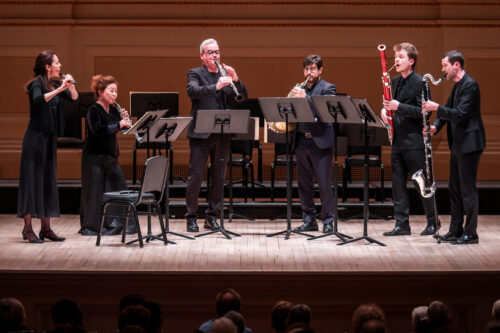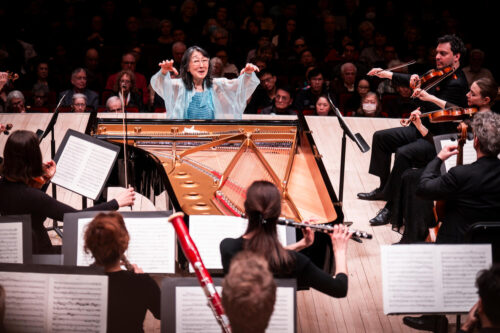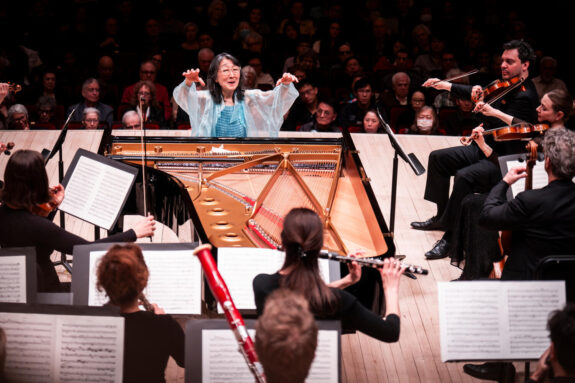 United States Mozart, Janáček: Mahler Chamber Orchestra / Dame Mitsuko Uchida (piano, director). Carnegie Hall, New York, 29.3.2025. (ES-S)
United States Mozart, Janáček: Mahler Chamber Orchestra / Dame Mitsuko Uchida (piano, director). Carnegie Hall, New York, 29.3.2025. (ES-S)

Mozart – Piano Concerto No.18 in B-flat major, KV456; Piano Concerto No.21 in C major, KV467
Janáček – Mládí
The last in the multi-year cycle of performances featuring Dame Mitsuko Uchida as both soloist and conductor of the Mahler Chamber Orchestra (MCO) in late Mozart piano concertos brought together another pair: Concerto No.18 in B-flat major and Concerto No.21 in C major. Composed just six months apart in 1784 and 1785, the two works inhabit distinct expressive worlds within Mozart’s mature Viennese period. They reveal the extraordinary emotional and structural range he achieved in the piano concerto form – shifting between inward delicacy and outward exuberance with effortless grace and always retaining a vocal-like suppleness. No.18, the less frequently performed of the two, is marked by rhythmic intricacy and a searching lyricism that often turns unexpectedly inward, particularly in its graceful Andante variations. No.21, by contrast, is one of Mozart’s most extroverted and symphonic concertos, with an orchestral richness that foreshadows Beethoven. Its famously serene slow movement – long detached from its context due to its use in Elvira Madigan, Bo Widerberg’s popular film – is framed by two movements of unflagging vitality and formal clarity.
With Uchida in the dual role of soloist and conductor, the concertos emerged as complementary expressions of Mozartean character. In Piano Concerto No.18, she favored intimacy over declamation, drawing out the music’s lyrical finesse with finely inflected phrasing and a delicate sense of timing. The dialogue between piano and winds was especially fluid in the first movement, revealing the concerto’s chamber-like spirit. Her trademark luminous and graceful touch was especially evident in the Andante un poco sostenuto, whose theme evokes Barbarina’s aria from Le nozze di Figaro. Alternating between major and minor, each of the variations was given its own expressive contour – from the delicate ornamentation of the opening to the darker-hued excursions in the minor mode. Uchida drove the final Allegro vivace with playful yet poised momentum, never sacrificing clarity for speed – a reminder of her always discerning approach to Mozart. Throughout, the orchestra played with a refined sense of balance. The ensemble’s cohesion was exemplary, from the warm phrasing in the strings under concertmaster José María Blumenschein to the expressive exchanges among the winds.

Piano Concerto No.21 revealed Uchida’s more extroverted side, with a bolder pianistic presence and a broader expressive sweep. The opening Allegro maestoso unfolded with stately momentum, its grandeur shaped not through volume but through clarity of articulation and a finely calibrated sense of direction. In the Andante, Uchida allowed the famous melody to hover weightlessly above the texture, eschewing sentimentality in favor of restraint, with every sound emerging unforced. Her playing traced long, unbroken lines, supported by the orchestra’s hushed, transparent accompaniment – particularly the tender contributions from the muted strings and the sustained serenity of the winds. The concluding Allegro vivace assai sparkled with crisp articulation and rhythmic buoyancy, the interplay between soloist and the slim ensemble (just three double basses) brimming with wit and lightness. As throughout the cycle, the mutual understanding between Uchida and the MCO instrumentalists – always responding with great dynamic control and unity of gesture – was something to marvel at.
All five performances in the traversal of Mozart’s late piano concertos featuring Uchida, begun in 2019, have followed a similar structure: two concertante works framing a purely orchestral segment, with repertoire from Purcell to Jörg Widmann. This March’s selection was as thoughtfully unexpected as any in the series: Leoš Janáček’s Mládí (Youth), a radiant and inventive wind sextet shaped by childhood memories and the vibrant speech rhythms of the composer’s native Moravia. Composed in the summer of 1924 when Janáček was nearly seventy, the work belongs to the astonishing final chapter of his career – a late, creative flowering fueled in no small part by his passionate, though platonic, relationship with Kamila Stösslová, a married woman nearly half his age who became his muse and emotional confidante. As this version made clear, the musical language – rhythmically agile, harmonically quirky, emotionally elusive – bears a kinship with Janáček’s The Cunning Little Vixen, composed just a year earlier: both works mix innocence with a sharp awareness of time’s passing. Like the opera, Mládí is not mere reminiscence but a defiant celebration of vitality in the face of age.
Scored for flute (doubling piccolo), oboe, clarinet, bass clarinet, bassoon and horn, Mládí expands the traditional wind quintet with the added depth and color of the bass clarinet. The MCO wind players gave a vivacious, finely shaded performance, capturing the music’s mercurial energy and wistful introspection. Their ensemble intonation was impeccable, and the rhythmic interplay – so vital in Janáček’s fragmented, speech-like writing – was handled with clarity and elastic precision.
Almost three decades after Claudio Abbado founded the Mahler Chamber Orchestra, the MCO remains a model of collaborative artistry, combining the virtuosity and deep musicality of its individual members with an exceptional sense of ensemble, especially striking in performances that unfold without a conductor.
Edward Sava-Segal
